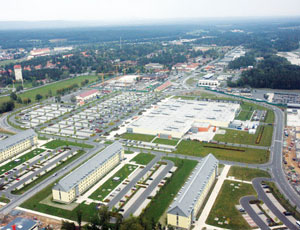Often, in nations hosting and building U.S. government facilities, U.S. armed forces engineers take plans to an early design stage and then hand off the projects to local government entities for execution, according to long-standing agreements worked out at diplomatic levels. For the U.S. Army Corps of Engineers, which builds in much of the world for the Army and often for the Air Force, Navy, Marines, various federal agencies and even foreign governments, agreements governing its construction tasks vary significantly.
“Every single place has different rules,” says Col. John S. Kem, commander of the Corps’ Europe District, whose area of responsibility includes Europe, the Middle East and sub-Saharan Africa.
In Germany, where the bulk of the district’s construction is done, there is a long-standing Status of Forces Agreement (SOFA) and the ABG 75 agreement, which govern fees for German-provided architectural, engineering and construction-management services. Except for the most sensitive or complex projects, the Europe District is required to accomplish most of its work in Germany through indirect contracting, in which projects are executed by municipal- or state-level government construction agencies called Bauamts.
Joseph McKenna, a Corps architect in Wiesbaden, says for most new construction and major rehabilitation jobs, the Corps gathers data through planning charrettes and develops schematic designs to 15%, which are then, under SOFA, handed to local Bauamts to commission design and engineering and manage the contracting and construction process. The Bauamts do not use design-build nor engage general contractors. They award contracts on a trade-by-trade basis.
In Kem’s words, the Corps can only “influence” delivery, but the flat-rate fees the Bauamts charge for the service are attractive: 5.6% of net project costs for new construction and 7.5% for conversions.
“It’s a very clear procedure,” says Kem. “We know what they do, and we know what we do.” But it also means many of the efficiency initiatives the Corps is implementing in the States have little room to work. “They’re just starting collaborative design. They are not doing ECI [early contractor involvement] and they have just started using BIM,” Kem says.
McKenna has four pilot BIM projects in development, two of which he will hand over at 15%. “And they have the option to scrap it and move forward,” he says.
The Corps influence grows with the size of the job, though. In some cases, such as the anticipated construction of a major hospital or time-critical or highly sensitive projects, it is allowed to skip the Bauamts and do direct contracting. In those cases design will usually be taken to 35%.
For fiscal years 2009 through 2011, the district expects to do about $1.25 billion through indirect contracts in Germany. It expects to award another $1.17 billion in direct contracts in Germany and in other countries in its area of operations, which includes a number of former Soviet Bloc nations.
But in many countries other than Germany diplomatic agreements governing U.S. military construction are much less fleshed out, or hardly exist “except at very senior levels,” Kem says.
“We have to proceed carefully because if we start doing something that runs counter to how things are done, it could inadvertently set policy,” Kem says. “We are breaking new ground. In Estonia, we have a SOFA, but there is...






















Post a comment to this article
Report Abusive Comment